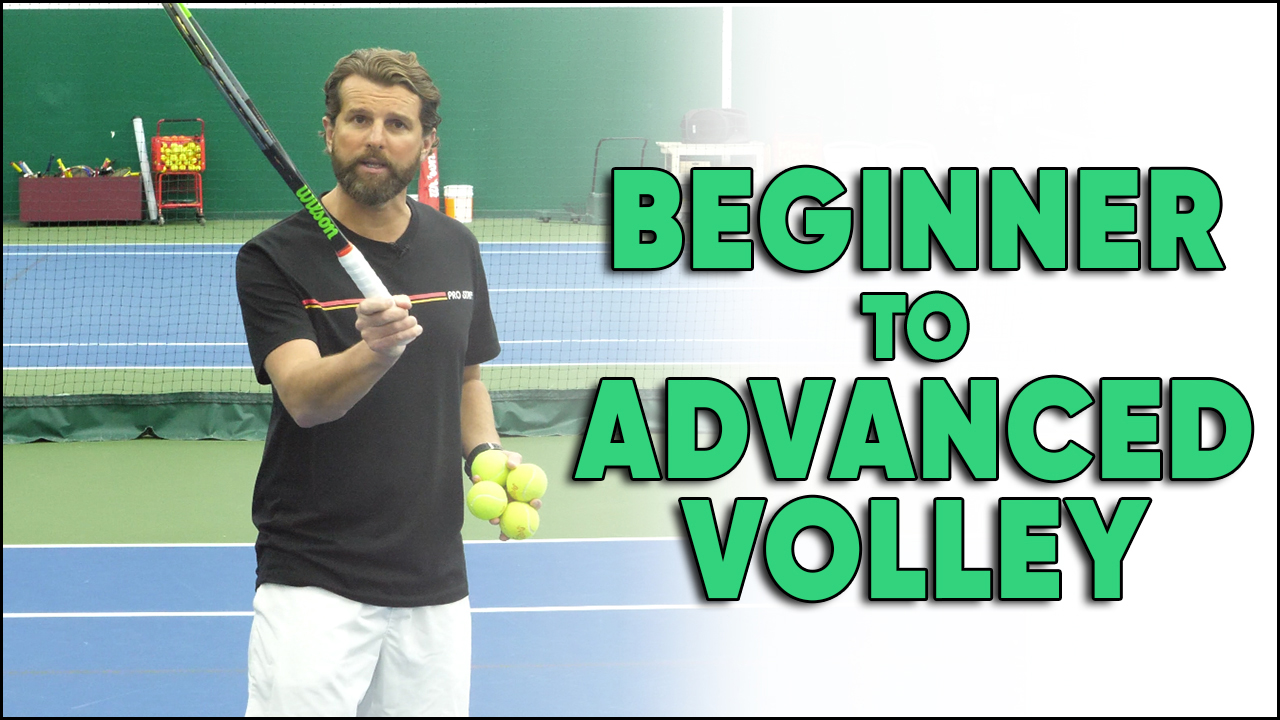If you aren’t doing these 3 things on your volley, you’re going to be stuck at the beginner level.
Want to meet new players & play more tennis? Try PlayYourCourt for free here: https://bit.ly/3dYsy8y
Want to dominate the net? Grab our Net Mastery Course for free here: https://bit.ly/37nqu8S
Nathan:
Hey guys. Nate and Scott here at PlayYourCourt.com. Today, we’re going to show you how to turn your 3-5 volley into a 4-5 volley.
Scott:
That’s right. This video is for players with a player court rating of 60 to 80. If you’re not in the community, try it for free and get your own PlayYourCourt rating.
All right, Nate. It’s a pretty big promise. You’re going to transform their volley from a 3-5 to a 4-5. I assume there’s some horrible error that we’re making … I’m going to fix here.
Nathan:
I’m going to build a road. I’m going to give them the pathway, and show them a couple errors they might be making, and show them the fixes that will take that volley to a 4.5 volley. Because a lot of times what’s happening in the errors … it’s a fundamental issue. And without fixing those broken fundamentals, they just can’t build that path to a 4.5. So, no. You’re not going to go and hit a 4.5 volley tomorrow, but your volley is going to greatly improve, and the consistency on it will hopefully improve so that it is a much higher level volley.
Scott:
Before we can dive in and start to really fix what’s wrong, we need to first talk about some of the fundamentals. They’re not sexy, but they’re super important. Item number one, you’ve got to use a continental grip. I know you hear this time and time again from all your instructors. It’s because it matters. The continental grip is when you take that base knuckle on your index finger as well as the heel pad on your hand, and you put both of them on the second bevel. Bevel one would be even with your frame on top. Bevel two is just one bevel over. That’s where your base knuckle and the heel of your hand are going to go for the continental grip.
Nathan:
Without the continental grip, without that fundamental grip for the volley, we just can’t get in the correct joint position. That is a huge issue. We can show you what the fix is, the pathway from 3.5 to 4.5. But if you are out there with the semi-western grip, it’s going to create a lot of problems. All right?
Scott:
Not only that. If you don’t have the continental grip, the continental grip is the only grip up at the net where you can hit forehand and backhand volleys without changing your hands around. If you want to hit a volley, if you want to volley at a high level, you’ve got to use this grip.
Nathan:
Absolutely. What’s happening is regardless if we have the continental or not, a lot of times the way that we perceive the volley is broken. What we end up seeing are players that when they get a high volley, they’re leading with the top edge to the ball. We’re going to show you that in just a moment, but it’s important that we discuss it first. A lot of times we see high volleys like whack-a-mole, and we’re leading with the tip. You can see with the Wilson Blade here it’s highlighted with this green … that I’m leading to the ball here. And that’s a problem because unless I’m really, really close to the net, the ball is only going to go down.
Scott:
That’s right.
Nathan:
On the exact opposite of that is that when we get a low ball, what we tend to do is that we drop our racquet and we end up almost producing topspin. We’re trying to lift the ball, because that’s how we perceive creating lift. When we do off-the-ground strokes, that makes sense. All right. This is especially obvious if players don’t have the continental grip, because it’s really about all they can do. If you’ve got a semi-western, this feels super normal, whether I’m going whack-a-mole or I’m trying to lift and roll a ball on a low volley. All right. What we really want to talk about is how to fix that with proper joint position and changing the ideology.
Scott:
If you’re ready to go ahead and fix that volley, smash that like button down below. And also guys, do us a favor. Press that subscribe button. I know you watch YouTube, and these guys always tell you hit the subscribe button. It actually does help our business. Do us a favor. Press that like button. If you’re excited about the instruction, press subscribe. Let’s dive right in.
Nathan:
Let’s get it.
The fix that we’re looking at to improve our volley, to level up that volley’s that when we go to hit a volley whether it is high or it’s low, or even that middle shelf volley, we always want to lead with the edge. You can see here with the Blade, the 3 and 9 is highlighted gray. That is the part of the racquet that should arrive to the ball first. You can tell it’s about a 45 degree angle in which I’m hitting the ball. Even if it’s low as I drive that edge, it allows the ball to take off like a jet. But because I’m producing backspin, the ball stays low.
Strategically it’s a much, much better volley. Now, even on a high volley as I lead with the edge, you can tell that it’ll create that slice that’s going to bite. As opposed to where I lead with the top of the racquet and I bounce the ball down, making it much, much easier for my opponent to get to the ball.
First off in this demo, I’m going to show you the incorrect way where players receive a high ball and they lead with the top edge often lead to either hitting it into the net, or bouncing it down to where their opponent can make it. Here even though I’m continental, when I lead with the edge I’m pulling that ball straight down. Even if I get it in, the ball bounces and it rebounds up so that my opponent can quickly get it.
In this next error, what I’m going to show you is what happens on a low ball. It’s one of two things when we don’t lead with the edge. I either have the racquet too open, as you’ll see here, to where I try to lead and I bounce the ball up because the racquet face is left open. Or what we see some players, especially players with that semi-western frying pan grip, is where they try to produce topspin on a low ball. They’re actually hating more of what would be like a swing volley at a low volley. Guys out there, if you were suffering from either of these two mistakes, leave a comment below. Let us know. As we show you the fix, let us know too if that helped you as well.
Scott:
We’ll get back to the coaching in just a second. But first, we really appreciate you watching our channel. As a thank you, we want to give you our six-part Net Mastery video course for free. This course will help you dominate the net. We normally sell it for $100, but if you stick around to the end of this video we’ll give it to you for free. All right. Let’s get back to the coaching.
Nathan:
Okay. Let’s take a look at what the improvement is on the volley. We talked a little bit about leading with that bottom edge, but we need to talk about the joint position as well. It’s extremely important that my wrist leads the elbow, and the elbow leads the shoulder. What we commonly see is the elbow gets tucked in. Sometimes that shoulder ends up a little bit before the elbow.
And then as far as the wrist is concerned, we want to make sure that the wrist is laid back. Especially if I’m in this semi-western grip, that frying pan grip, you can tell the wrist lays back differently. It’s more as if you were going to try to hammer a nail. From here, it’s off-centered. This is important here with the wrist. Now, with leading with the edge, what you’re going to see is that the ball is going to bite through the court instead of sitting up as the previous method.
All right. Now, the low volley. Even though my racquet is traveling down with the strings open, the backspin still makes the ball go up, but keep the ball nice and low in order for me to attack the net.
All right, guys. The takeaways today is absolutely get that continental grip. Make sure that is what you’re using for your volleys. Then the main point here is that when you go to volley, lead with the bottom edge. Remember, it’s okay to swing a little bit as long as it’s in front of you. We just don’t want the racquet well behind you.
Scott:
You don’t want no one behind you. That’s a big one too, man. Because so many coaches say, “Don’t swing at the volley.” What we mean is don’t take your racquet back behind you.
Nathan:
Yeah. I mean, it’s hard to time an incoming ball and your racquet’s way back here. So, in front of you. Use that slice, that slight high to low with the edge leading to really raise your game when you’re coming to the net.
Scott:
All right, guys. Hopefully that helped. Also make sure you check out the first comment down below. We’ve got two pretty great things for you. One, if you want to try the PlayerCourt Community for free, there’s a link where you can do that. Also, if you want our Net Mastery course, be sure and grab it down there in the comments section as well. See you guys soon.

